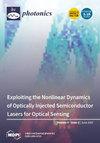基于光学相控阵的激光束阵列细分像素法提高三维成像分辨率
IF 2.1
4区 物理与天体物理
Q2 OPTICS
引用次数: 0
摘要
目前的线性模式雪崩光电二极管(LM-APD)阵列像素数量较少,限制了其三维(3D)成像分辨率。我们采用基于光学相控阵的光束阵列细分像素法来提高三维成像分辨率,利用光学相控阵生成与 LM-APD 阵列像素数量相同的光束阵列,并匹配位置,控制光束阵列中的每个子光束在相应像素的视场中扫描。光束阵列中的子光束发散角小于 LM-APD 阵列中单个像素的瞬时视场角。子光束在单个像素视场中的扫描实现了 LM-APD 阵列对目标三维信息的多次采集,从而提高了 LM-APD 阵列的分辨率。模拟了光束阵列在远场的分布,并分析了三维成像的主要性能参数。最后,利用液晶相位调制器作为光学相控阵设备,对 20 米外的目标进行了实验,结果证明我们的方法可以将分辨率从 4 × 4 提高到 8 × 8,至少提高了四倍。本文章由计算机程序翻译,如有差异,请以英文原文为准。
Optical Phased Array-Based Laser Beam Array Subdivide Pixel Method for Improving Three-Dimensional Imaging Resolution
The small number of pixels in the current linear mode avalanche photodiode (LM-APD) array limits its three-dimensional (3D) imaging resolution. We use an optical phased array-based beam array subdivided pixel method to improve the 3D imaging resolution, using an optical phased array to generate a beam array with the same number of pixels as the LM-APD array and matching positions and controlling each sub-beam in the beam array to scan in the field of view of the corresponding pixel. The sub-beam divergence angle in the beam array is smaller than the instantaneous field of view angle of a single pixel in the LM-APD array. The sub-beam scanning in a single pixel’s field of view realizes the multiple acquisition of the target 3D information by the LM-APD array, thus improving the resolution of the LM-APD array. The distribution of the beam array in the far field is simulated, and the main performance parameters of 3D imaging are analyzed. Finally, a liquid crystal phase modulator is used as an optical phased array device to conduct experiments on a target 20 m away, and the results prove that our method can improve the resolution from 4 × 4 to 8 × 8, which can be improved at least four times.
求助全文
通过发布文献求助,成功后即可免费获取论文全文。
去求助
来源期刊

Photonics
Physics and Astronomy-Instrumentation
CiteScore
2.60
自引率
20.80%
发文量
817
审稿时长
8 weeks
期刊介绍:
Photonics (ISSN 2304-6732) aims at a fast turn around time for peer-reviewing manuscripts and producing accepted articles. The online-only and open access nature of the journal will allow for a speedy and wide circulation of your research as well as review articles. We aim at establishing Photonics as a leading venue for publishing high impact fundamental research but also applications of optics and photonics. The journal particularly welcomes both theoretical (simulation) and experimental research. Our aim is to encourage scientists to publish their experimental and theoretical results in as much detail as possible. There is no restriction on the length of the papers. The full experimental details must be provided so that the results can be reproduced. Electronic files and software regarding the full details of the calculation and experimental procedure, if unable to be published in a normal way, can be deposited as supplementary material.
 求助内容:
求助内容: 应助结果提醒方式:
应助结果提醒方式:


